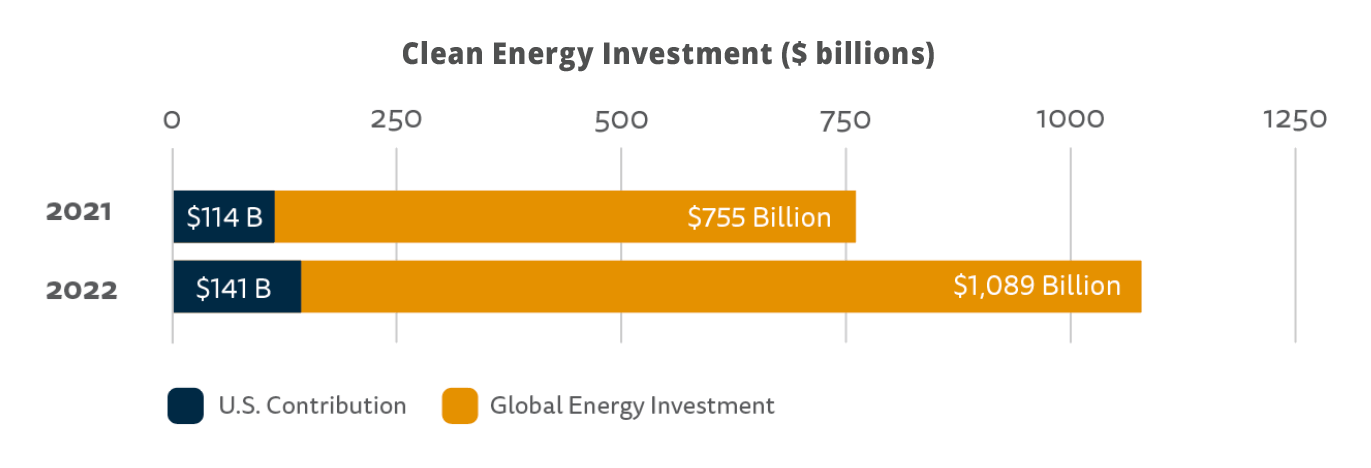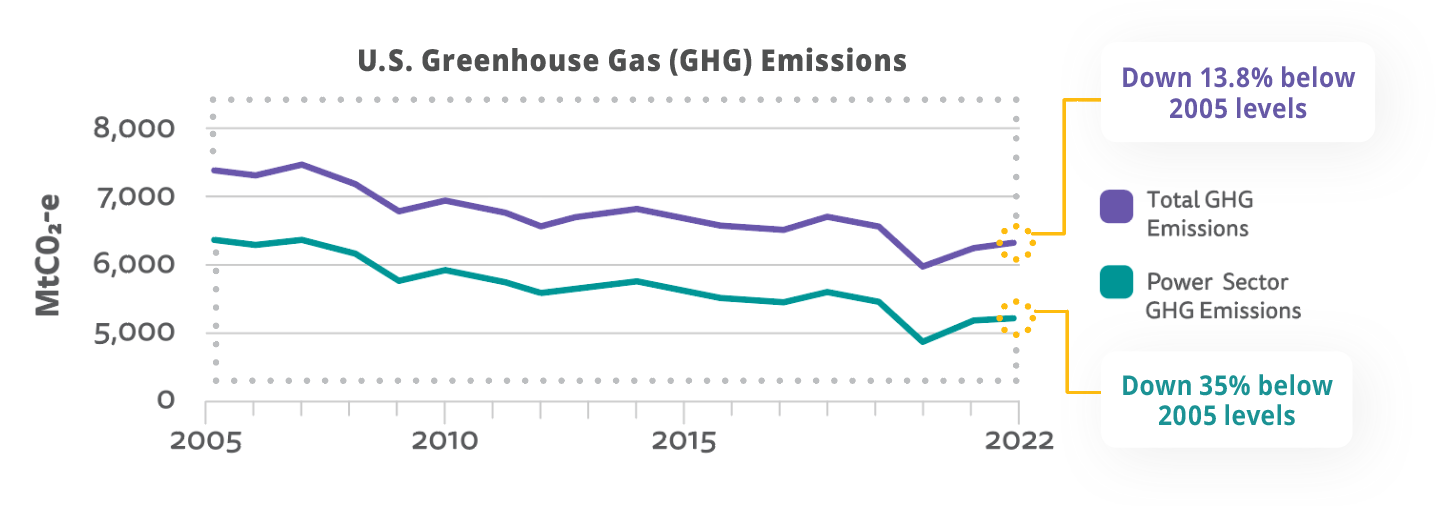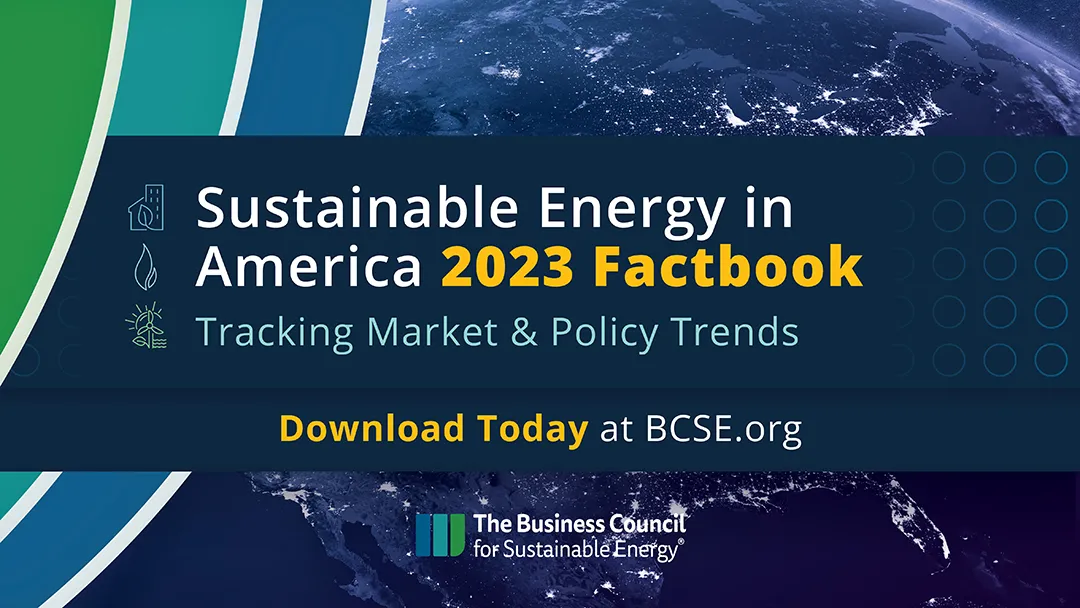By Lizzie Stricklin, Communications Manager, BCSE
Investment in clean energy generation and technologies shattered records in 2022, even as supply chain disruptions, an international energy crisis, and rising interest rates elevated prices for key energy commodities. Notable political successes, as well as growth in clean energy power generation and electric vehicle adoption, reveal that the clean energy transition is now hard-wired into the U.S. economy.
That’s the key takeaway from the 2023 Sustainable Energy in America Factbook, released earlier this month. Produced annually by the Business Council for Sustainable Energy and BloombergNEF, the Factbook tracks energy market and policy trends in the United States, examining how clean energy sectors performed in 2022 and over the past decade.
Here are some of the top clean energy trends from 2022:
1. Global private investment in the energy transition shattered records in 2022.

Investment in clean energy is thriving. Global private investment rose to over $1 trillion in 2022, with the United States attracting the second-highest level of investment at $141 billion – an 11% increase over 2021. The 2022 total included $57.3 billion in electrified transport (41%) and $49.5 billion in renewable energy (35%). Large corporations continued to drive clean energy demand in the U.S., signing contracts to procure a new annual record of 19.9 gigawatts (GW) of renewable energy in 2022, up from 17.1 GW in 2021.
This increase points to the durability of the energy transition, even when faced with inflationary and supply chain pressures. Corporate demand, coupled with a historic public sector injection of capital into U.S. infrastructure, is sure to exponentially expand the reach of the clean energy transition, which is rooted in a diversified portfolio of energy efficiency and clean energy.
2. The BCSE portfolio of clean energy solutions provide the majority of U.S. electricity.

The share of U.S. electricity demand met by natural gas and renewable energy increased to 62% in 2022, up from 43% in 2012. Renewable energy broke records, meeting 13% of total energy demand and 23% of electricity demand. Coal-fired generation fell to 19.4% of the power generation total, and nuclear generation delivered 18%.
Unpredictable headwinds remain the norm for energy markets. Obstacles in 2022 included Russia’s invasion of Ukraine and the subsequent impact on global energy markets, as well as high input commodity prices for clean energy technologies. Nevertheless, the U.S. power sector’s transition to cleaner resources endured, showing strong demand by companies, communities, and households. The passage of the Inflation Reduction Act also provides, for the first time, parity and long-term support for the full portfolio of renewable energy technologies.
3. U.S. energy productivity dipped 1% in 2022, but over the past 10 years it has grown 15.2%.

The U.S. economy expanded 1.9%, and U.S. primary energy consumption rose at a faster clip of 3%, returning to pre-pandemic levels. Nevertheless, since 1990, the energy productivity of the U.S. economy (GDP output per unit of energy consumed) has improved 79%, demonstrating that investments in energy efficiency have paid dividends. Spending on energy efficiency improvements related to electricity stabilized at $6 billion while spending on improving the efficiency of natural gas delivery grew from $1.5 billion to $1.7 billion in 2021 (latest data available).
Energy productivity – a measure of economic output per unit of energy consumed in the United States – is an essential metric to grade our country’s competitiveness compared to other Group of Seven nations. Energy efficiency is at the heart of meeting U.S. economic competitiveness and decarbonization goals.
4. 2022 marked the third most costly climate disaster year on record, with U.S. greenhouse gas emissions inching up 1%.

U.S. economy-wide greenhouse gas emissions rose 1% following a 5.8% increase in 2021, but emissions remained 3% below pre-pandemic (2019) levels and 13.8% below 2005 levels. This suggests that some emissions reductions made in 2020 have persisted, particularly for transportation, the top emitting sector, and for the power sector, which has seen steady decarbonization for the last decade due to clean generation and energy efficiency.
Climate-related disasters caused $165 billion in damage, making 2022 the third most costly year on record. Eighteen of these disaster events individually caused more than $1 billion in damages. Three tropical cycles accounted for 70% of the $165 billion total. Natural disasters in 2022 forced an estimated 3.4 million Americans to evacuate their homes, according to the U.S. Census Bureau.
These trends call for the urgent acceleration of the speed and scale of the deployment of clean energy and energy efficiency solutions. Climate-related disasters place undue strains on public coffers and community well-being. The energy system is critical infrastructure that needs immediate attention to avoid the negative consequences of extreme weather and natural disasters.
5. Relative energy costs of U.S. households remained historically low in 2022, even as consumers faced price increases due to supply chain disruptions and inflation.

Energy spending accounted for 4.6% of total U.S. personal consumption expenditures in 2022, up 0.63 percentage points from 2021 levels. Nationwide, 1.74% of household expenditures went to electricity and natural gas in 2022, up only slightly from the 2021 level of 1.63%. However, transportation-related energy consumption spending rose from 2.1% in 2021 to 2.65% in 2022.
Even as the U.S. energy economy has transformed over time to embrace cleaner resources and has become more efficient, the energy costs of U.S. consumers have remained relatively low and stable. Nevertheless, 27% of U.S. households had difficulty meeting their energy needs in 2020 (the last year for which there is complete data), leading them to forego other necessities to pay an energy bill or to maintain their home at an unsafe temperature, according to the Energy Efficiency Impact Report. Further investment in energy efficiency is critical, especially in low-income communities.
The 2023 Sustainable Energy in America Factbook is free to download at bcse.org/factbook. Dive deeper into the facts by checking out the Executive Summary, Key Trends, and additional Clean Energy Industry Resources.
About the author: Lizzie Stricklin is the Communications Manager for the Business Council for Sustainable Energy.

